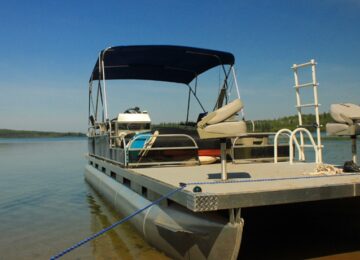Have you ever wondered how larger water vessels cruise through the waters with such ease? It is because of their marine propulsion systems.
The evolution of marine propulsion systems has come a long way. During ancient times, the wind helped voyagers circumnavigate vast oceans. On the other hand, small boats used human power and tools, such as paddles, to propel themselves on the water.
Today, humongous water vessels use complex propulsion systems and advanced technology for naval expeditions. Not only does it enhance the performance of the watercraft but also improves the safety of seafarers amid unpredictable waters. Continue reading this article to learn more about marine propulsion systems.
The Evolution of Propulsion System
Human Power
Before the inventions of machines, people relied on human power and tools to sail through the waters. The tools early humans used were paddles and oars. Mostly, they cruised around smaller bodies of water, such as lakes.
Humans learned to use both human and wind power by combining sails and oars in their ships.
Despite the more advanced marine propulsion systems, some water vessels still use human power to propel themselves.
Boats for recreational activities, such as dinghy boats and kayaks, still use paddles. In sports, dragon boat races use the power of more or less 22 people to course through the waters.
Paddlewheel
A paddle wheel is simply a wheel with paddles. Its structure is similar to a Ferris wheel but replaces the cabins with paddleboards.
It is the early form of mechanical marine propulsion systems. Steam powers up this mechanic. But how does a paddlewheel work?
With the help of steam power, the paddlewheels rotate forwards or backwards. As it spits, the paddleboards that act as oars push against the water, producing a thrusting force.
For large vessels, paddle wheels are installed at the rear parts of the watercraft, whereas in smaller boats, two paddle wheels are on both sides.
The use of paddle wheels has ceased due to its inefficiency in unreliability in the rough waters. Modern and more efficient marine propulsion systems had replaced paddlewheels.
Turbines
Turbines are rotating devices that look like a wheel with blades around the rim. Steam turbines in marine propulsion systems use a cylindrical casing as an enclosure.
Turbines work by spinning its blade at high speed using steam power.
Since the paddlewheels and turbines, people have come up with prototypes of modern propellers. Now, modern propellers have given birth to several types of marine propulsion systems, including the hybrid marine propulsion system and marine electrification.
Types of Modern Marine Propulsion Systems
From human power to machine, down to steam, modern marine propulsion systems today have evolved diesel-power and marine electrification. But before we discuss these propulsion systems, let us first understand propellers.
Like turbines, propellers are devices or machines with blades that form a circular or spherical appearance. Like turbines, it produces a thrusting force by spinning the propellers at high speed. The most basic example of propellers is your electric fans.
Watercraft and aircraft have propellers. Some planes have their propellers on their noses, while aircraft, such as the helicopter, have them on top.
Here are the common types of modern marine propulsion systems:
Diesel propulsion system
The most common and popular marine propulsion system in water vessels is the diesel propulsion system. This system uses thermal energy from burning diesel to produce a mechanical force.
Like other marine propulsion systems, the diesel engine is connected to the propeller shaft. Once the diesel burns, the thermal energy is converted to mechanical force, causing the propellers to spin.
Both large vessels and smaller boats use this propulsion system. The diesel propulsion system has a fair share of disadvantages as well. Apart from the tremendously high price of diesel fuel, this energy is not sustainable at all. Its burned byproducts, such as plumes of thick smoke, largely contribute to the shipping industry’s carbon footprint. Additionally, the smokes contain toxins and air impurities that are bad for your health.
The solar electric propulsion system
Engineers utilised the benefits of renewable energy for more sustainable marine propulsion systems in the industry using solar power.
Before wheel paddles, ships used the wind to propel the vessels using sails. In the solar electric propulsion system, engineers use wind and solar energy to operate the watercraft.
Firstly, ships use the marine-grade solar panels installed to collect sunlight for the battery packs of the solar-powered system.
Secondly, ships use an array of rigid sails with marine-grade solar panels for wind energy.
Cruise ships, passenger vessels, and RoRo vessels usually use the solar electric propulsion system.
This system and other solar-powered marine engines pioneer sustainable and environmentally-friendly marine electrification.
Diesel-electric propulsion system
The diesel-electric propulsion system, also known as the hybrid marine propulsion system, uses fuel and electricity to propel a boat.
Diesel engines are attached to an electric generator that produces electricity, which powers up the propellers.
Compared to the diesel propulsion systems, the diesel electric drive has a more compact engine, reducing the vessel’s weight. Moreover, this hybrid marine propulsion system also consumes less diesel fuel.
Diesel electric drive systems are much quieter and more sustainable than pure diesel-powered engines.
Nuclear propulsion system
One of the most complex marine propulsion systems is nuclear propulsion.
Vessels using nuclear propulsion systems have nuclear reactors on board that produce nuclear fission reactions. Nuclear fission reaction emits heat and steam energy that creates electricity. The electricity then powers up the propulsion system. The ship’s batteries store surplus electricity.
One of the advantages of nuclear propulsion systems over other marine propulsion systems is that these engines do not need much re-fuelling. They are perfect for vessels that stay in the waters for long, including naval ships and submarines.
Conclusion
Some other types of marine propulsion systems are available in the market, including water jets, tri-fuel, and wind propulsion systems.
The key to finding the right propulsion system is considering several essential factors. It includes your type of vessel, cost, maintenance, and sustainability.
If you are gearing towards marine electrification, visit E-POD. E-POD provides a high-grade hybrid marine propulsion system. Visit E-POD today.











